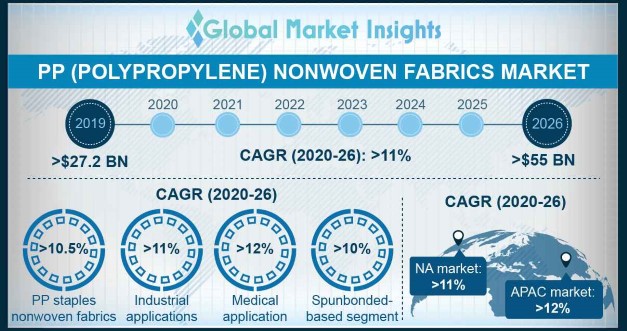Home > Chemicals & Materials > Textiles > Nonwoven Materials > Global Polypropylene (PP) Nonwoven Fabrics Market
Global Polypropylene (PP) Nonwoven Fabrics Market Size
- Report ID: GMI838
- Published Date: May 2020
- Report Format: PDF
Polypropylene Nonwoven Fabrics Market Size
Polypropylene (PP) nonwoven fabrics market size exceeded $27 billion, globally in 2019 and is estimated to exceed above 11% CAGR between 2020 and 2026. Rapid demand for adult incontinence and hygiene products will foster market growth during the forecast period.
Polypropylene nonwoven fabrics are fabric like materials which are produced from short staple fibers and long fibers, bonded by mechanical, chemical, or heat treatment. They are mainly used in the textile manufacturing industry. Nonwoven fabrics are mainly engineered fabrics, which have a limited life, are durable, and can be used only once. They provide functions such as liquid repellence, absorbency, softness, flame retardancy, strength, thermal insulation, bacterial barrier, acoustic insulation, and wash ability.
Polypropylene (PP) is the key raw material used for producing nonwoven fabrics owing to low cost, flexibility, moderate strength & stability, lightweight, excellent moisture resistance, high temperature resistance, and insulation properties. PP nonwoven fabrics have wide applications in geotextiles, furniture, medical, hygiene products, agriculture, and medical.
| Report Attribute | Details |
|---|---|
| Base Year: | 2019 |
| Polypropylene (PP) Nonwoven Fabrics Market Size in 2019: | 27.2 billion (USD) |
| Forecast Period: | 2020 to 2026 |
| Forecast Period 2020 to 2026 CAGR: | 11% |
| 2026 Value Projection: | 55 Billion (USD) |
| Historical Data for: | 2015 to 2019 |
| No. of Pages: | 350 |
| Tables, Charts & Figures: | 553 |
| Segments covered: | Product & Applications |
| Growth Drivers: |
|
| Pitfalls & Challenges: |
|
Increasing application scope in hygiene products including female hygiene products and baby diapers is likely to stimulate polypropylene nonwoven fabrics market value of nonwoven fabrics owing to their properties such as lightweight, softness, high strength wet & dry, free from chemical agents, and dermatologically neutral. These key performance metrics increase application scope in baby diapers, which are appropriate for infant’s delicate skin.
Rapid technological advancements and innovations in this field, such as design of nonwoven fabrics with skincare and softness, have further led to the polypropylene nonwoven fabrics market growth. For instance, in December 2017, Arvind Ltd. and OG Corporation of Japan entered into a joint venture for manufacturing and trading specialized materials.
The new manufacturing facility in India will help OG Corporation to expand its business in India within the nonwoven fabrics space. The joint venture will produce high-quality non-woven fabrics using needle-punch technology for artificial leather, bag-house filtration, and other applications.
However, the polypropylene nonwoven fabrics market share may be hampered by strict regulations imposed by regulatory authorities and the unorganized textile industry. Strict regulations imposed by REACH over environmental concerns may impact industry growth. Rising cases of COVID 19 among population have disrupted manufacturing industries and supply chains, hindering market growth to a certain extent. Consumers are significantly reducing purchases across all product categories owing to adverse effects of the COVID-19 pandemic on employment.

